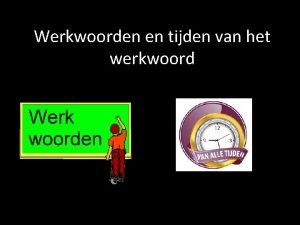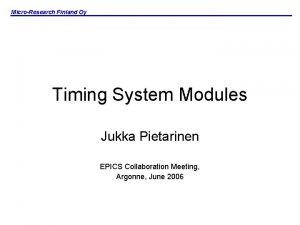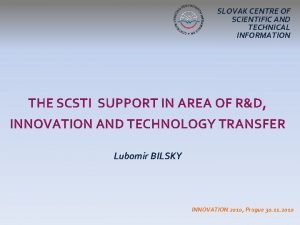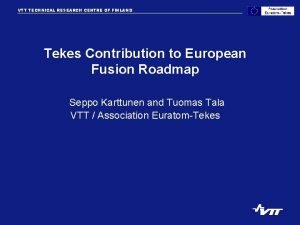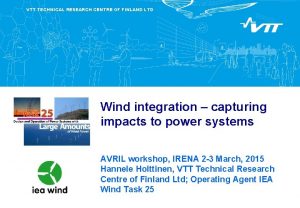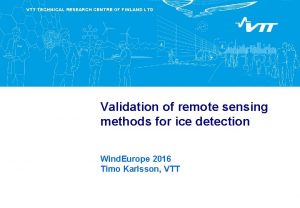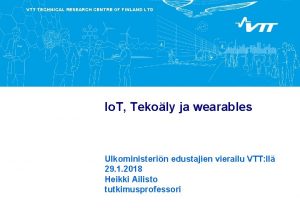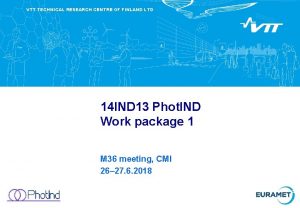VTT TECHNICAL RESEARCH CENTRE OF FINLAND LTD Wind












- Slides: 12

VTT TECHNICAL RESEARCH CENTRE OF FINLAND LTD Wind integration – capturing impacts to power systems AVRIL workshop, IRENA 2 -3 March, 2015 Hannele Holttinen, VTT Technical Research Centre of Finland Ltd; Operating Agent IEA Wind Task 25

Wind power in the power system: impacts on reliability and efficiency Adequacy Balancing Grid 02/03/2015 2

Task 25 - Reports published § Summary report: § Recent study results and experience § Recommended Practices: § Information about methodology § To provide research institutes, consultants and system operators with the best available information on how to perform a wind integration study § www. ieawind. org 02/03/2015 3 3

Recommendations for integration studies –flowchart 4 Simplified No need to do all steps – for first studies Production cost simulation and Load flow can suffice Recommended route Iterations 4

Main recommendations § Input data: Synchronous wind generation and load time series § representative for regions (smoothing impact) § Capturing wind capacity value 10 years, for balancing 1 year ok § Forecast data, uncertainty at different time scales § Dispatch simulations: § Model the impact of uncertainty on commitment decisions. § Model the limitations of flexibility (ramp/start costs, part load efficiency, minimum online load; using interconnections for balancing) § Load flow – more cases to study. Dynamic stability: for higher penetration levels, also wind support to grid § For larger penetration levels, changes in the remaining system may be required 02/03/2015 5

Summary of recommendations § Assumptions crucial for results – neighbouring system, wind/load input, flexibility related inputs; also main set-up, remaining system, questions asked § Iteration loops are important - alternatives to future power plant mix, transmission build-out, operational practice § Field is evolving, model development ongoing § Characterizing study limitations (over/underestimating) § Results § Relative to penetration level – both by capacity and energy § Most things apply for solar as well variable integration 02/03/2015 6

Issues for long term planning models § Generally integration impacts not captured – underestimating impacts of high shares of wind and PV § Restrictions from balancing and grid the main concerns, also capacity value of wind not straightforward § Capturing grid restrictions, especially stability issues at high penetration levels § Iterations with grid model – for some more crucial hours § Grid is a constraint in balancing task § Grid needs to be prepared for higher penetration levels (usually higher means > 5 -10 % of yearly energy depending on existing grid). This can take 10 years so grid studies are important to conduct separately § Stability is an issue usually for larger shares of >20 % 02/03/2015 7

Issues for long term planning models § Capturing balancing task difficult § Cycling burden– capturing flexibility constraints like start-up costs, minimum load restriction, part load efficiency, ancillary services § Variability detail – peaks/high generation hours’ flexibility problems § Storage options needs temporal/chronological constraints § How much can sharing with neighbours help (grid constraints /operational practices) § Mitigation options § Iterations with more detailed models to sub-regions § Iteration simulating a shorter time with more detail § How to choose the weeks to simulate to capture all relevant situations with geographical interdependencies § Capturing capacity value of wind power (capacity value as function of wind share), assumptions on neighbouring areas 02/03/2015 8

Summary § Integrating larger shares of variable generation - capturing balancing task is difficult § Balancing costs will be dependent on the generation fleet and operational practices - Flexibility needs may impact the investment decisions § Grid infra and stability issues impact the costs – may impact the balancing taska and the investment decisions § Any power system planning for larger shares would need to study operation in detail with TSO involvement and collaboration with larger areas § but can start building the first 5 -10%. Simpler models can be used for smaller shares of VRE 02/03/2015 9

10 IEA WIND Task 25 participants France and Mexico joining in 2015 hannele. holttinen@vtt. fi http: //www. ieawind. org/t ask_25. html Country Institution Canada Hydro Quebec (A. Robitaille); Manitoba Hydro (T. Molinski) China SGERI (Bai Jianhua, Zhang Qin) Denmark DTU Wind (P. Sørensen); TSO Energinet. dk (A. Orths) EWEA European Wind Energy Association (I. Pineda) Finland VTT (H. Holttinen, J. Kiviluoma) – Operating Agent Germany Fraunhofer IWES (B. Lange); TSO Tenne. T (A. Gesino) Ireland ECAR/UCD (Mark O’Malley); TSO Eir. Grid (J. O’Sullivan) Italy TSO Terna Rete Italia (Enrico Maria Carlini) Japan Tokyo Uni (Junji Kondoh), Kansai Uni (Yoh Yasuda) Norway SINTEF (John Olav Tande, Atle Rygg Årdal) Netherlands ECN (Jan Pierik); TUDelft (M. Gibescu) Portugal LNEG (Ana Estanquiero); TSO REN (Jose Osario); INESC-Porto (J. Pecas Lopes); UTL-IST (Ferreira Jesus) Spain University of Castilla La Mancha (Emilio Gomez Lazaro) Sweden KTH (Lennart Söder) UK DG&SEE (Goran Strbac, Imperial; O. Anaya-Lara, Strathclyde) USA NREL (M. Milligan); UWIG (J. C. Smith); Do. E (C. Clark)

TECHNOLOGY FOR BUSINESS

Future work / Research needs § New simulation tools § Uncertainty of wind power on different time scales § Transmission planning with low capacity factor resources § Transmission grids offshore HVDC § Wind turbine capabilities and models for simulations § Flexibility metrics and tools § Ways to set up simulation cases to extract impacts § Higher penetration studies – also stability issues § Market design issues 02/03/2015 § Incentivize needed new generation and flexibility characteristics? § Incentivize flexibility in operational time frame? § How does wind power impact the market? 12
 Wat is een koppelwerkwoord
Wat is een koppelwerkwoord Micro research finland
Micro research finland Raumschotkurs
Raumschotkurs Jtspl
Jtspl Jagruti technical services pvt ltd photos
Jagruti technical services pvt ltd photos Orchid technical consultancy p ltd
Orchid technical consultancy p ltd Goodhill korea centre pte ltd
Goodhill korea centre pte ltd Toyota motor europe nv sa
Toyota motor europe nv sa Slovak centre of scientific and technical information
Slovak centre of scientific and technical information Centroid in mechanics
Centroid in mechanics Center of gravity formula for different shapes
Center of gravity formula for different shapes Wmt&r
Wmt&r Sunrise agriland development & research pvt. ltd.
Sunrise agriland development & research pvt. ltd.
